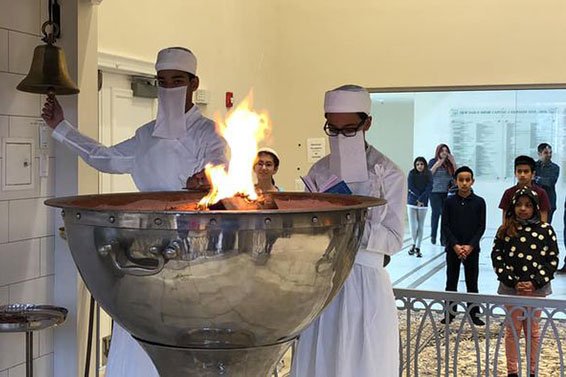Zoroastrian priests have masked for millennia | Faith Matters
“Dad, everyone’s wearing a mask!” exclaimed the son of Adi Sidhwa, a Zoroastrian priest, about the COVID mask requirement. “Is it different than yours?”
The boy wasn’t referring to his father’s COVID mask but the long, white, cloth one – padan — that Sidhwa, 46, from eastern Bergen County, wears when he presides at the service in the Pomona, New York, temple. A Zoroastrian priest, also referred to as mobed, has always worn a mask when performing prayers in front of the sacred flame used in most Zoroastrian ceremonies.
Sidhwa explained that there are two parts to the religious mask with a disposable one underneath “out of an abundance of caution.”
One reason for the mask is that no saliva or germ travel from the mouth to contaminate the fire that is considered pure and symbolic of the divine, said Sherazad Mehta of Hoboken who, along with his two children, worships at the Pomona Temple.
Mehta also noted that even prior to COVID, wearing masks by ordinary people has been common in parts of Asia so they cover their mouths if they may be getting sick or when they cough or sneeze.
“It’s just common sense,” Mehta said.
Turning mask wearing in the COVID era into a political scenario is absurd, he said. He rejects the response of some that they do not want to be told what to do.
For Zoroastrian children, seeing priests in masks is an expected, calming and strength-giving sight. They are also very familiar with masks and are likely to associate masks with prayers, peace and community. They are less likely to be scared of masks or people wearing masks.
“As a boy, I was intrigued,” Mehta said.
All Zoroastrian rituals and ceremonies are performed in the presence of a sacred fire. Zoroastrians are not fire-worshippers, as some wrongly believe, though. Zoroastrianism, one of the world’s oldest surviving monotheistic religions, venerates all natural elements. Fire is a powerful purifier and the “spark” in every human being.
North America’s Zoroastrian community includes two main groups: those who arrived from India, called Parsis, and those who came directly from Iran, often seeking religious freedom. There’s also a group called “Iranis” who emigrated from Iran to British India in the late 19th century. There are new pockets of converted Zoroastrians in Kurdish Iraq and elsewhere.
Worldwide estimates of the number of Zoroastrians range from over 100,000 to as many as a quarter million, which makes it the smallest world religion.
Sidhwa was born into a priestly family in Mumbai, which enabled him to also become a priest if he chose, which he did. He started preparing at age 12. He also lived in Thailand, England and Nepal before moving to the United States 20 years ago.
He first learned to tie a kusti, a cord, around himself and wear a sudrah, a vest, like, he said, “armor,” in a personal ritual, which records “our good thoughts, word, deeds.”
At some point, Zoroastrian teenagers go through a ritual – navjote – prior to puberty, which is a kind of Confirmation in the faith. After that ceremony, they perform their kusti or prayers twice a day for about five minutes each.
“Our almighty God is worshipped through the medium of fire,” Sidhwa told me.
Priestly study begins by learning 28 verses by heart — each “verse” can be several pages long — to master the basic phase of priestly formation. Eventually, one graduates to 72 verses to become a full-fledged priest after being quizzed by the high priest. Afterward, the new priest spends 30 days in three purification baths that can take up to nine days each.
The normal temple ceremony starts with a prayer, and the priest then performs a ritual, addresses the community and concludes with several prayers. In Pomona, it is done in communally with several priests among some 500 worshippers usually once a month.
Sherazad — a civil engineer who has overseen the temple’s property and served as a trustee — believes Zoroastrianism “sets out a path for righteousness.” Adherents, he said, believe and strive for “good words, good thoughts and good deeds.” And that’s unmasked by the good lives they strive to live.
Next week, we will look at how Zoroastrian women are advocating inclusivity in their leadership.





